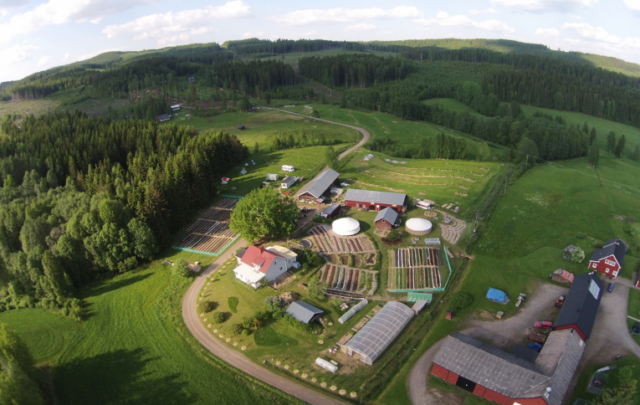
How much oil, coal and gas the world is extracting?
The Guardian
The Bakken bust continues
Mason Inman, Failing Gracefully
In North Dakota’s Bakken shale oil play, the drilling boom has gone bust. It may only be a temporary bust—but aren’t all booms, and all busts? Here I show a compilation of the latest data from North Dakota, assembled in advance of the state’s monthly release. Production was down 1.5 percent from January to February, that’s in addition to a 3.1 percent decline the month before.
Fracking Operators Ran Up 2.5 Violations a Day, Study Shows
Mark Drajem, Bloomberg
Oil and gas drillers ran afoul of regulators on average 2.5 times a day in three energy-intensive states for mistakes such as wastewater spills, well leaks or pipeline ruptures during the boom in hydraulic fracturing.
Online records in West Virginia, Pennsylvania and Colorado showed regulators issued 4,600 citations from 2009 to 2013, the Natural Resources Defense Council said Thursday in a report. The report excluded violations in 33 other states with drilling because such records aren’t available on the Internet.
“It’s extremely difficult for the public to get this kind of information,” said Amy Mall, an author of the report for the New York-based environmental advocate. “The companies are violating the law too often, and we need policy solutions to increase transparency and to change the consequences for not complying” with the rules, she said…
New study raises possible link between gas drilling and radon levels
Jon Hurdle and Susan Phillips, NPR
Radon levels in buildings near unconventional natural gas development in Pennsylvania are higher than those in other areas of the state, suggesting that hydraulic fracturing has opened up new pathways for the carcinogenic gas to enter people’s homes, according to a study published on Thursday. Radon is the second leading cause of lung cancer worldwide.
Researchers from Johns Hopkins University analyzed radon readings taken in some 860,000 buildings, mostly homes, from 1989 to 2013 and found that those in rural and suburban areas where most shale gas wells are located had a concentration of the cancer-causing radioactive gas that was 39 percent higher overall than those in urban areas…
Top 12 Media Myths On Oil Prices
Dan Doyle, Oilprice.com
The upstream oil and gas industry is not a black hole. There’s no mystery wrapped in an enigma here. There are a lot of meetings with engineers, chemists and geologists. There’s a constantly evolving learning curve. And then there’s all the regulations and compliance. But all-in-all it’s pretty straight forward, that is, until the media gets a hold of it. That’s when it becomes complicated. It’s as though we are getting reports from the mysteries of the deep ocean or life in the great galaxies beyond. There is so much hyperbole and unsupported guesswork that investors don’t have a chance. So, in a small effort to set the record straight, let’s see if we can’t dispel some of the misinformation…
Misperception #5: The Baker Hughes rig count has become irrelevant. Incorrect. The Baker Hughes rig count is always relevant. Remember, this was the weekly number that allowed us to hold a bottom at $43 in March. But because supply didn’t immediately go lockstep with the falling count, analysts lost patience. They are now theorizing that rigs are so “productive” that the count no longer carries the weight that it once did. That’s a tough position to take. We were at 1,600 rigs drilling for oil in October and we’re now at 800. There is some truth that E&Ps are now favoring sweet spots but that won’t make up for the 50% collapse in the count. Shale extraction resembles an industrial process more than it does wildcatting. There aren’t many dry holes with shale. Microseismic advances have put an end to that as have data rooms stuffed full of old well logs that chart the potential of shales. Thus, most shale wells drilled today have a much better chance of being economic than step out and exploratory wells of the past. There is no legitimate model for 800 rigs growing US production past 8.9 mm BOPD in the Lower 48. And because its shale, and because shale is “tight”, drilling must continue at a breakneck pace to grow production. Analysts looking for a more ‘spot on’ number should start following the activity of fuel distributors who run nonstop between depots and frack jobs. Watch their sales for a more immediate indication of future production….
What energy democracy looks like
Craig Morris, energytransition.de
One of Germany’s political foundations, the Rosa Luxemburg Foundation, has produced a video in English explaining the term “energy democracy” to North Americans. It was made in cooperation with labor unions and thus focuses on job creation. Craig Morris likes the presentation but fears some main points might not be highlighted enough.
Can the world economy survive without fossil fuels?
Larry Elliott, The Guardian
The final chapters of The Bone Clocks, David Mitchell’s 2014 novel, describe a future in which progress has gone into reverse. In 2043, the fossil fuel age is over: nuclear power stations ar e melting down, there is no access to the electricity grid and solar panels are so prized that they are looted. Catastrophic climate change has become a reality. Rising sea levels have caused floods on the New York City subway, killing thousands. Internet coverage is patchy, food and consumer goods are scarce, and life‑saving drugs such as insulin are hard to come by. It is a dystopian vision that looks like a brutal, dangerous version of the past – one not at all like the future that was promised when the cold war ended with victory for the western capitalist model. If it comes to pass, it will be because, despite all the warnings, climate change has not been taken seriously enough…
Why This New Study On Arctic Permafrost Is So Scary
Emily Atkin, Think Progress
Scientists might have to change their projected timelines for when Greenland’s permafrost will completely melt due to man-made climate change, now that new research from Denmark has shown it could be thawing faster than expected.
Published Monday in the journal Nature Climate Change, the research shows that tiny microbes trapped in Greenland’s permafrost are becoming active as the climate warms and the permafrost begins to thaw. As those microbes become active, they are feeding on previously-frozen organic matter, producing heat, and threatening to thaw the permafrost even further.
In other words, according to the research, permafrost thaw could be accelerating permafrost thaw to a “potentially critical” level…
Western Canada’s glaciers could shrink by as much as 95% by 2100, study finds
Robert McSweeney, Carbon Brief
The Canadian Rockies, which sit as a backdrop to many a stunning vista, could be almost entirely devoid of glaciers by the end of the century, a new study suggests.
Researchers modelled the impact of rising temperatures on glaciers across western Canada.
The results show widespread ice loss by 2050, and ice all but vanishing a few decades later…
The Corrections: Jonathan Franzen’s Deeply Irresponsible Climate Change Article
Joe Romm, Climate Progress
The New Yorker has published one of the most bird-brained and hypocritical climate articles ever, “Carbon Capture: Has climate change made it harder for people to care about conservation?” Quick answer: No!
Awareness of and action on climate change are entirely about conservation — conserving a livable climate for humans and all other species. Aggressive climate action now would be an immediate boon to the overwhelming majority of living things, although I do think some tropical diseases, jelly fish, pests and other invasive species might lose out.
But the New Yorker and the blinkered author of this piece, one Jonathan Franzen, actually would like to “preserve nature at potential human expense.” Franzen frames our choice this way: “The Earth as we now know it resembles a patient whose terminal cancer we can choose to treat either with disfiguring aggression or with palliation and sympathy.”
In the distorted “through the looking glass” view of this piece, sharply reducing most air pollution ASAP would be “disfiguring” while the most sympathetic approach is allowing us to destroy a livable climate capable of sustaining a multi-billion human population and most existing species! And yes, Franzen actually argues that destroying a livable climate irreversibly will allow us to focus on preserving nature temporarily…
Exhausted world stuck in permanent stagnation warns IMF
Ambrose Evans-Pritchard, The Daily Telegraph
The global economy is caught in a low-growth trap as innovation withers and the population ages across the Northern Hemisphere. It will not regain its lost dynamism in the foreseeable future, the International Monetary Fund has warned.
The IMF said the world as a whole has seen a “persistent reduction” in its growth rate since the Great Recession and shows no sign of returning to normal, marking a fundamental break in historical patterns.
This exposes the global economic system to a host of pathologies that may be hard to combat, and leaves it acutely vulnerable to a fresh recession. It is unclear what the authorities could do next to fight off a slump given that debt ratios are already at record highs and central banks are running out of ammunition…
Is Travel Behavior Changing? What the New Data Says
Steven Polzin, Planetizen
To recap: about ten years ago evidence accumulated indicating that the rate of travel growth over the prior 50 years was no longer the norm, as travel demand showed signs of moderation. Subsequent data revealed that Vehicle Miles of Travel (VMT) per person peaked in 2004 and has moderated since that time, while total national VMT peaked in 2007 and showed declines in three of the seven years since then [1]. The stretch of decreases and modest increases continued until a 1.7 percent year-over-year increase recorded for 2014, according to the Federal Highway Administration [pdf].
In 2014, total VMT passed the three trillion level for only the third time and was very near the peak 2007 level. If the preliminary estimate holds, 2014 VMT will rank as the second highest ever and the first year since 2004 showing an increase in per capita VMT. But with 17 million more people, VMT per capita remains below peak levels…
Forest degradation as bad for climate as deforestation, says report
Sophie Yeo, Carbon Brief
Degradation of tropical forests could be as severe a problem as full-scale deforestation when it comes to their carbon emissions.
While not as widely recognised within policymaking circles, the steady deterioration of forests across places such as the Amazon and Borneo could be responsible for 6-14% of all human-caused emissions.
This is the finding of a new review into the state of the world’s tropical forests, conducted by the International Sustainability Unit, a charity backed by Prince Charles.
The problem demands a re-evaluation of forest policy, which leans towards stemming deforestation as the key to curbing tropical forest emissions, says the report.
Carbon Brief looks at the role of forests in curbing climate change…






